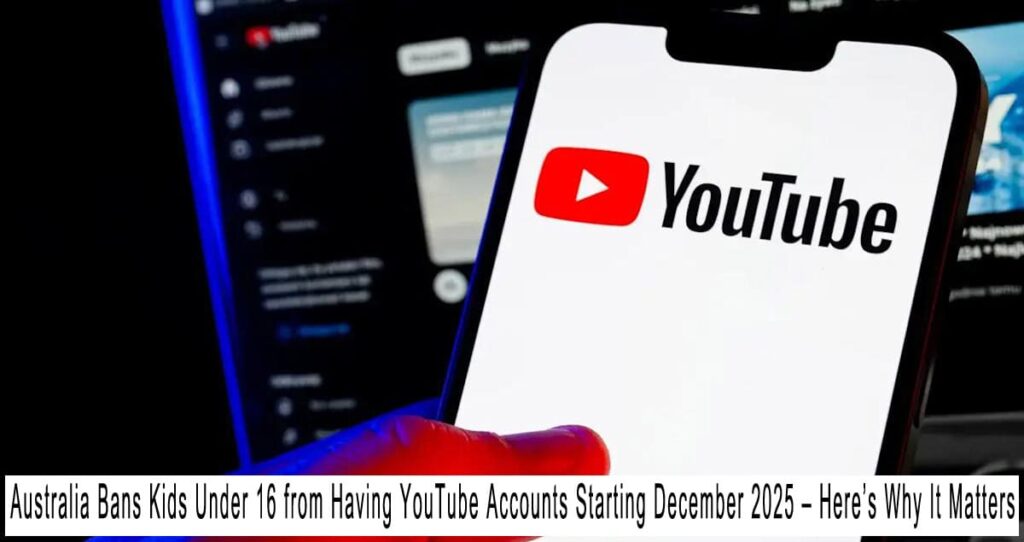Australia Bans Kids Under 16 from Having YouTube Accounts – Australia is taking bold steps to protect kids’ mental health and safety in the digital world. Starting December 10, 2025, children under the age of 16 will no longer be allowed to create YouTube accounts. This isn’t just another internet rule—it’s part of a major shift in how the country regulates social media. https://dontkilladream.com
Australia Bans Kids Under 16 from Having YouTube Accounts Starting December 2025
So, What’s the New Rule?
The Australian government has announced that by the end of this year, all social media platforms—including YouTube, TikTok, Instagram, and Snapchat—must restrict users under 16 from having an account.
That means:
- Kids can’t create new accounts if they’re under 16.
- Existing accounts must be deactivated by the platforms.
- Platforms must actively verify users’ ages.
This is part of an overhaul to the country’s Online Safety Act, and will be enforced by the eSafety Commissioner, Australia’s top authority on digital safety.
Why Is YouTube Being Targeted?
Interestingly, YouTube wasn’t initially seen as a “social media platform” by the government, since it’s mainly a video-sharing site. But new research shows kids are more likely to encounter harmful content on YouTube than anywhere else.
According to Australia’s eSafety office:
“4 out of 10 children reported encountering inappropriate or harmful content on YouTube.”
That includes violent material, hate speech, conspiracy theories, and even borderline sexual content—all slipping through the cracks.
Age Verification—But Not With an ID
Making sure someone is of legal age is one of the most difficult aspects of this legislation. But here’s the thing: platforms aren’t required to ask for official ID like a driver’s license or passport.
Instead, platforms can:
- Use behavioral signals and existing account data
- Leverage AI and moderation tools
- Follow government-issued age assurance guidelines
The idea is to protect kids without compromising their privacy—a tricky but necessary balance.
Big Fines for Rule-Breaking Platforms
If platforms ignore the rule? They’re in trouble. A fine of AUD 50 million, or approximately USD 33 million or IDR 527 billion, is the highest amount that the government has set.
The eSafety Commissioner also has the power to demand platforms take down accounts, disable features, or even limit services across Australia if they don’t comply.
What About YouTube Kids?
Good question. As of now, YouTube Kids hasn’t been directly named in the regulation. Since it’s built specifically for younger audiences—with content filters and parental controls—it’s likely to stay available.
Still, questions remain: Will logins be required? Will parental controls be mandatory? How will YouTube ensure the content is genuinely child-friendly?
Why Set the Limit at 16?
Australia believes 13 (the current global minimum age for most platforms) just isn’t enough.
Communications Minister Michelle Rowland said kids that young can’t fully understand:
- How their data is collected and used
- The risks of algorithm-driven content
- The long-term impact of their digital presence
For context:
- EU law (GDPR) also sets a 16-year minimum, unless countries opt for lower
- The US uses 13 (COPPA law)
- Tougher age-checking regulations are also being considered in the UK and Norway.
How Did YouTube Respond?
YouTube says they’re reviewing the new rules and remain “committed to child safety.” But they also raise concerns about how the law will work in practice.
Google’s official statement:
“We welcome global discussions around digital age regulations, but we hope they’re evidence-based, inclusive, and practical to implement across different platforms.”
What Are Parents and Creators Saying?
Some parents are relieved—finally, a clear rule to help set digital boundaries. But others worry this could stifle creativity, especially for kids who love making content, vlogging, or joining educational communities online.
Even some child content creators in Australia argue that YouTube isn’t like TikTok or Instagram—there’s no DM feature, no stories, and minimal social interactions.
They believe it should be treated differently.
What Does This Mean for Parents Outside Australia?
Even if you’re not in Australia, this could still affect you. Big tech platforms often roll out global changes based on new regulations in one country.
So you might soon see:
- Stricter age checks when signing up
- More parental control tools
- Adjustments in YouTube’s algorithm or recommendations for young viewers
Now’s the time to:
- Start talking with your kids about online content
- Explore safe, supervised digital spaces
- Teach critical thinking when it comes to the internet
Final Thoughts
Australia’s move to ban under-16s from creating YouTube accounts is more than just policy—it’s a signal to the world that tech companies must be held accountable for how they treat young users.
As parents, educators, and online users, we have the opportunity to:
- Rethink how kids interact with platforms
- Demand safer, more transparent tech
- Put wellbeing before clicks
Because at the end of the day, digital safety starts at home.




